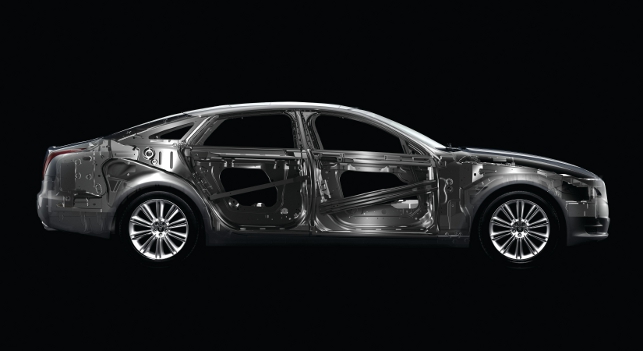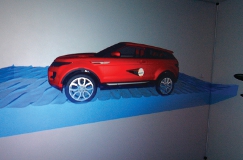Jaguar Land Rover’s heritage comprises some of the greatest vehicles ever created, including the iconic Jaguar Mark 2, the E-Type, and Land Rover Defender.

The chassis of the Jaguar XJ luxury saloon – X351
Having passed through the corporate hands of several companies including Ford, Jaguar Land Rover (JLR) is now owned by Tata Motors, which the company deems to be an exciting and dynamic global enterprise.
A glance at the Jaguar C-X16 or C-X75 shows the shape of things to come, while high acclaim greeted Range Rover’s recent launch of the lighter, greener Evoque. Turning heads in Chelsea, Cheltenham and the foothills of Kanchenjunga, Nepal, the Evoque is a true inheritor of its parent brand’s hard-won esteem.
Complex history
Due to its varied ownership history, JLR inherited a mixed bag of auto industry software from its previous owners.
Paul Davies, JLR’s director of product development operations, leads the teams that define JLR’s vehicle development processes, tooling technology, and project and Product Lifecycle Management (PLM) technologies for 8,000 JLR people worldwide.
“The challenge of expanding JLR’s vehicle portfolio into segment-defining products requires strong technical foundations,” says Davies. “Our IT history has generated more than 600 islands and silos of JLR legacy data. The majority is not inter-compatible. To flourish in business, all our data must be interoperably integrated and intuitively available to every JLR stakeholder.”
To enhance innovation and reduce development time, JLR has partnered with Dassault Systèmes (DS) to deploy Version 6 in a business transformation programme called iPLM. “Version 6 provides a powerful yet simple out-ofthe-box PLM solution with Enovia as its backbone and Catia, Delmia, Simulia, and 3DVIA to deliver business and engineering value across the JLR organisations,” comments Davies.
“Many business users, and even suppliers of PLM strategies, fail to understand its end-to-end power. They see PLM as a data management system rather than a business transformation (BT) tool, as IT rather than BT,” he adds.
JLR iPLM covers the entire vehicle definition and features across 14 domains. These include bills of material, parts and assembly, requirements and verification, plus invehicle embedded software, which accounts for 60 per cent of new car development. Electrical design, styling, and computer-aided engineering, including multi-physics and finite element analysis (FEA), are also included.
“Version 6 enfranchises data users and managers with 3D visualisations of all product data and manufacturing operations,” comments Davies. “Assembly and disassembly routines with legislative parts and vehicle governance data are readily available in manageable formats.
The immediate benefit of creating, seeing, experiencing and sharing data in a Version 6 environment is translating into time savings of up to 40 per cent for some specific roles in product development.”
Smooth is fast
Version 6 deployment also delivers improvements in vehicle volumes and quality at JLR.
For example, iPLM produces precise cost-benefit criteria for more informed decision making. “Version 6 delivers extra time for innovation so that JLR can build more and better vehicles,” comments Davies .
“Version 6 provides a seamless operating world, with extensive Tier-One supplier involvement. These factors, and the considerable financial and business benefits that iPLM delivers, mean that JLR can add vehicle programs and smoothly accelerate global product development,” he says.
John Knight Gregson, iPLM program lead at JLR, adds: “JLR deploys DS Version 6 from vehicle design concept, through engineering and manufacturing, to marketing and sales. It’s a robust, seamless and integrated solution that delivers data consistency across suppliers, financial control and supply chains. An ERP interface provides further systems and process synchronisation and management.
Working with Version 6 generates a single version of the truth at JLR and brings high-percentage efficiency returns. Data that is entered once is shared and reused many times. Concurrent engineering between teams across the world generates collaboration with a guarantee of accuracy that cuts waste while improving productivity.”
iPLM facilitates bringing 3D digital models and product definitions into context and further use by JLR and its suppliers. “Version 6, provides enterprise wide availability of Catia 3D product simulation assets. This allows people to more fully engage with JLR and its spirit of innovation.
Sharing designs synchronises teams at JLR. Engineers, manufacturers, marketing and sales, feasibility, sourcing, and finance can collaborate earlier with the joint vision Version 6 delivers,” says Gregson.
3DVIA extends ‘digital enfranchisement’ even further providing accurate live, current and fully validated 3D data both within and beyond JLR. It reduces errors, losses and waste by providing accurate timely information. These factors raise morale as people work with PLM solutions matched to their needs.
Team challenge
As design progresses, Delmia Version 6 simulates and validates JLR production environments virtually, including buildings, production cells and technicians, who are represented by lifelike digital manikins.
“Simulated digital representations in Delmia enable optimisation of our production environments,” explains Gregson. “3D digital factory overviews, coupled with highly detailed machining operations, allow us to more fully understand and further optimise operations. This also enhances processes and their interactions at JLR. These measures also augment sustainable development through efficiencies leading to reduced energy and resource usage.
Enovia Version 6 provides JLR a single source for regulatory and materials compliance data that is available to all stakeholders. “This helps JLR increase scale and volume of products with confidence of compliancy.
Enovia Programme Central manages collaboration and helps to deliver business acceleration through concurrent working. Davis added: “When information is open and shared, skills can be deployed more effectively. This data availability means people can work up to 20 per cent more efficiently,” adds Gregsen.
According to him, iPLM makes better use of resources and introduces multiple efficiencies. For example, errors are detected and corrected earlier to produce significant savings. “Virtual build improves physical build quality and productivity through enhanced training and cognition for production engineers. It also values fitted parts in real time, providing an accurate business cost of each vehicle made,” he says.
Beyond the enterprise
iPLM with Version 6 extends beyond the JLR enterprise, supporting access by JLR dealers, service engineers, and customers.
“This allows vehicle purchasers and drivers to more fully understand ranges and option choices for better driving, owning and servicing experiences,” comments Davies.
Version 6 and iPLM are being jointly developed by JLR and Dassault Systèmes to become the automotive industry’s’ most advanced PLM system. “We chose Dassault Systèmes as a partner, not just on technical or commercial merit, because they display the same level of passion and pride in their business as Jaguar Land Rover does,” says Davies.
“Together we are building a lifelike product experience system that connects us to our products and communicates throughout the enterprise using the universal language of 3D,” he adds. 
Dassault Systèmes Version 6 PLM helps expand Jaguar Land Rover’s portfolio
Default








